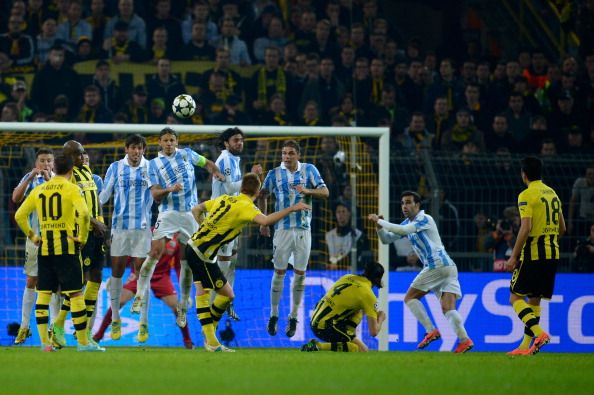
Dortmund 3-2 Malaga: Tactical Analysis
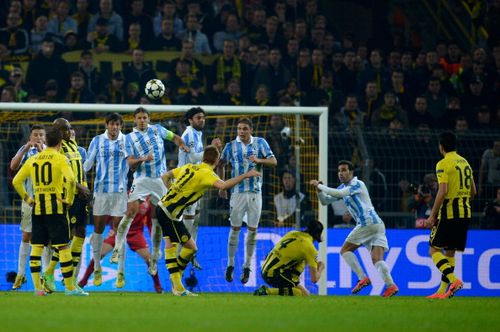
Malaga travelled to Germany for their second leg clash against Dortmund which was scheduled for the 9th of April 2013. The two squared off for the second time in a week, resuming at 0-0, which was the score after 90 minutes at La Rosaleda after the first leg. On a night of thrilling European football, Dortmund had to score 2 late goals in order to get past the plucky Spanish side.
The home team began in its usual 4-2-3-1 formation, with Kuba making a comeback to the side to start on the right side of the attacking trident behind Lewandowski, and Bender accompanying Gundogan in central midfield. Big defender Mats Hummels was only fit enough to make the bench, and therefore, the defensive side of the team remained unchanged.
Malaga had to make some enforced changes, with captain Weligton sitting out due to suspension, along with Manuel Iturra. They were replaced by Sergio Sanchez and Ignacio Camacho respectively. Going forward, Julio Baptista started as a striker, with his place in the line of attacking midfielders being taken by Duda, who served as captain for the game.
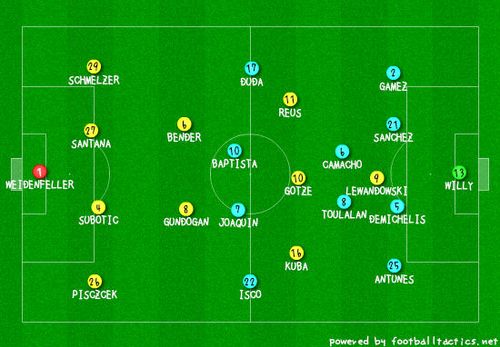
via Ousideoftheboot’s Tactics Creator
Dortmund:
Passing Patterns:
Usually, Dortmund employ, and enjoy a short passing game. On this night though, Malaga’s tactics made it imperative that Dortmund look for routes other than their usual ones. In response, Dortmund started attempting a lot more long passes, and aerial passes. Despite this being out of their comfort zone, Dortmund had to do so in order to get their flair players into the game. All in all, they attempted 67 long passes, and in the air, they rose to the occasion, winning a majority (56%) of the headed duels. Individually, Lewandowski had an important role to play in this, as he held the ball up well, apart from winning 4 of his 8 headed duels.
Dropping off:
Malaga were playing a little deeper, and trying to use runners like Isco, Joaquin and Duda to play off the big man Baptista. In order to counter this tactic, The Dortmund backline started dropping off every time a long pass was played in the direction of Julio Baptista. While this may have been effective in terms of not allowing runners in behind them, it created a little space in front of the defence, which Malaga exploited well enough to score. The opening goal from Joaquin Sanchez came as a result of the space created in front of the defenders by this tactic.
Creation of space:
In order to stop Dortmund playing their high tempo one touch football in midfield and the final third, the Malaga team squeezed very close together to reduce the space between the lines, thus making it very difficult to play short passes in between the lines. In order to create space to play their passing game, Dortmund tried two tactics. First, they played a lot of passes amongst their defenders in deeper areas of the pitch. This was done in an attempt to draw the Malaga forwards onto them, and thus create space in midfield for the likes of Gundogan to drop into and receive the ball. This didn’t work well, as the Malaga players were very disciplined, allowing Subotic and Santana to play a monstrous 146 passes combined.
The second tool used to create space was the long diagonal ball. The Malaga defence was trying its best to hold a line outside the penalty area, a space which Dortmund excel at utilising. To get them away from this area of the pitch, so that their forwards may be able to occupy it, Dortmund needed to push the Malaga defence back. They did so by playing long diagonal cross field passes between the defensive lines and the keeper. While Willy came up and took a lot of these, the defenders obviously moved deeper to intercept these cross field passes, as strikers like Lewandowski constantly made darting runs to receive these crosses.
Wide play:
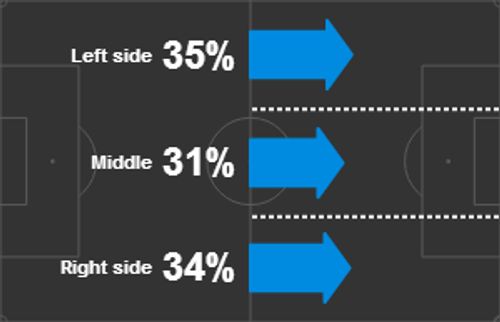
Only 31% of the play was through the middle. (Image courtesy whoscored.com)
Dortmund are a team that love to play through the middle, and pass their way through the opposition. On this occasion, they couldn’t manage it against a tough Malaga side. Therefore, they took the best alternative route, through wide areas. Not only did they begin to rely on crosses, but they also tried to stretch the Malaga defence by getting players committed in wide areas, thus increasing the area each man in the centre had to cover. Altogether, der BVB played 23 crosses on the night, and only channelled 31% of their play through the middle.
Malaga:
Covering space:
Visiting one of the most daunting arenas in world football, Pellegrini decided to make his Malaga team hard to beat by closing down spaces that Dortmund require to play their attractive style of football. This meant that a disciplined approach was required from everyone on the pitch. Malaga lined up in a sort of 4-4-2 while defending, with Joaquin playing alongside, rather than behind the striker Baptista.
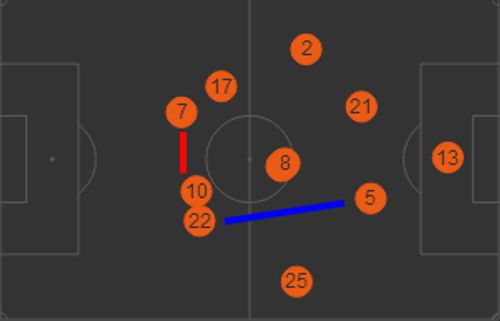
The red line shows the Malaga forwards playing along side each other to close down space.
The blue lie indicates the closeness between the offensive and defensive lines of the Malaga team.
via whoscored.com
If he were behind Baptista, the space to their left and right would be open for passes, but by playing alongside each other, the duo managed to cover a lot more horizontal space, making it very difficult for the Dortmund defenders to get the ball to their play-makers. Even the other midfielders, Isco and Duda tried the same tactic, creating a wall of 4 in front of their defensive minded players. The problem was accentuated by the absence of Mats Hummels, who usually serves as a very good play-maker from the back.
This tactic helped Malaga counter the problem that was posed by the likes of Reus and Gotze whose movement and skill makes them so hard to stop. By not allowing the ball to get to them, they almost negated their effect.
Squeezing Play:
A tactic employed to reduce space was the squeezing tactic that Pellegrini used to make his defence very compact. Basically, he reduced the space between the attacking and the defensive lines to a minimum. This served the purpose of reducing the space between the lines that Dortmund enjoy playing in so much. It also meant that the midfield area got very congested, as a lot of players were occupying space. As a result, this part of the pitch witnessed 45% of the action, and the squeezing tactic allowed Malaga to break up play better. They ended up making 18 interceptions, with a majority of them coming in the wider midfield areas, as Dortmund tried to evade the crowded centre.
Long balls aimed at Baptista:
The Malaga strategy in attack was to hit the big man up front, who would hold up play and look for runners from midfield to join him. The big man for Malaga was Julio Baptista, and he was accompanied by Duda, Joaquin and Isco. Isco in particular, stayed very close to him, so as to pick up on any loose balls and passes. This tactic worked very well for Malaga, and they couldn’t make more of the game in an attacking sense simply because they didn’t have enough of the ball (32% possession). In fact, with Dortmund dropping off deep every time Malaga played the ball to Baptista, the attacking midfielders of Malaga enjoyed a lot of space, and Joaquin took full advantage by striking a well placed shot into the bottom corner to score the opening goal of the night.
Midfield teamwork:
Pitted against one of the most fearsome attacking combinations in all of Europe, the Malaga defensive midfield duo of Toulalan and Camacho put in a wonderful performance. The duo stuck close together throughout the game, and covered each other. Offensively, they looked to supply the attacking players, but defensively, they played a major part in keeping Dortmund out for long periods of the game. Not only did they run their socks off to close down opposing midfielders, but made a good contribution with defensive actions too. Jeremy Toulalan stood out once again, with the Frenchman making 2 interceptions, 6 tackles and 7 clearances.
On a big night, when the match was in the balance, Pellegrini used some smart tactics to take the game to Dortmund, making it very hard for the former winners to play their natural game, but the Germans came out on top, excelling against some unfamiliar tactics. If they carry on in this vein, they are surely a side to be feared.